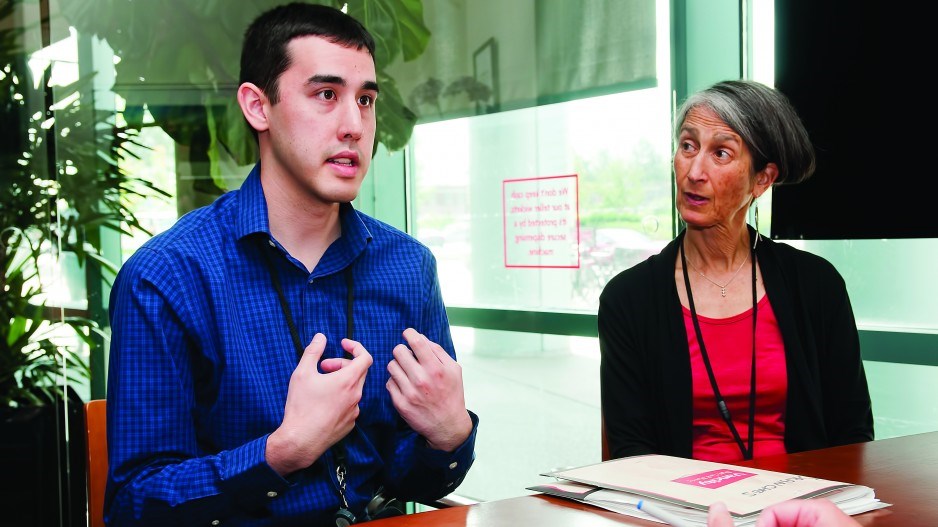Paddy Gallagher had worked at a dollar store and volunteered at the Vancouver Aquarium before starting work at Vancity Credit Union a year and a half ago. But working at Vancity was his first office job, and he was nervous.
“I was afraid of pushing one button, and – whoops, there goes all the money!” he jokes.
Gallagher started out doing basic office tasks to prepare for the credit union’s intensive five-day orientation sessions for new employees, but gradually added tasks such as scheduling, sending out cheque requests and ordering office supplies.
Then the 25-year-old, who has been diagnosed with a type of autism called Asperger syndrome, started doing a presentation to new employees on diversity and how he came to work at Vancity.
He now mentors other employees who have been employed through Vancity’s work inclusion program, which aims to increase the number of employees with disabilities in the credit union’s workforce.
Vancity is one of six B.C. employers highlighted by the BC Centre for Employment Excellence as being “disability confident” in hiring, and more importantly, retaining employees who have a disability.
It didn’t happen overnight, said Ellen Pekeles, vice-president of operations for Vancity.
“In the beginning, we weren’t very good at really relying on the employee to share with us what they needed to succeed in the workplace,” said Pekeles. “If we didn’t set them up properly up front, it didn’t work out very well.”
Karen Henderson, who owns three Tim Hortons franchises and operates a fourth in downtown Vancouver, had a similar experience.
“It was not a success,” the former recreational therapist said of an early attempt. “It was too early in our business plan … and we didn’t have the time or energy to spend with team members to give them that little extra TLC and encouragement.”
Henderson and Pekeles both highly recommend working with service agencies that work closely with their clients on interview, resumé and work readiness preparation. Those agencies also work closely with employers and existing employees to teach them how to create an inclusive workplace.
“The [employee] comes with a coach and they work side by side to do the training,” said Henderson.
“I’m working with three or four different programs and they do regular check-ups to see if there’s any extra training needed, are they not doing something right or do we want to add a task.”
Out of 90 employees in total, Henderson has employed 10 people with developmental disabilities, five of whom are currently working in the restaurants doing cleaning work. The strategy has been positive for workplace morale.
“It’s given some stability to my workforce … the job they’re doing is taking stress off other team members,” Henderson said.
Pekeles pointed out that 15% of B.C.’s population identify as having a disability. Vancity has set a goal of employing over the 5.8% provincial labour rate for people with disabilities, and has encouraged its employees to voluntarily disclose whether they have a disability – including mental health issues – in a confidential HR process.
“People have asked, ‘Why do you want to know if I have a disability?’” Pekeles said. “The answer is so we can support you better if we know what your challenges are, we can support you to be successful.”
Vancity has so far mostly hired for entry-level jobs, but in the future Pekeles would like to focus on management and executive-level positions.
“We don’t have anyone on our board or on our executive team with disabilities, and I think there would be so much learning,” Pekeles said. “But people have to have so many skills to do that, so I think we’ll look at management opportunities in the future.”
Gallagher has learned a lot in his first office job, but he believes the teaching has gone both ways.
“Even my co-workers at first didn’t know what to expect from me,” he said, “but they learned lots.”




